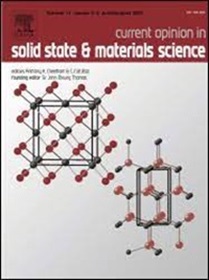Advances in additive manufacturing of cemented carbides: From powder production to mechanical properties and future challenges
IF 13.4
2区 材料科学
Q1 MATERIALS SCIENCE, MULTIDISCIPLINARY
Current Opinion in Solid State & Materials Science
Pub Date : 2025-07-26
DOI:10.1016/j.cossms.2025.101238
引用次数: 0
Abstract
Cemented carbides, which combine refractory metal carbides with binder phases, are essential advanced engineering materials for modern industry, spanning manufacturing, mining, energy production, aerospace, and defense. Their unique properties enable critical applications in cutting tools, drilling equipment, molds, dies, and wear-resistant components, making them vital in today’s technological landscape. Cemented carbides have traditionally been produced using powder metallurgy (PM) techniques. However, these conventional methods have limitations in tooling and molding, particularly for creating complex geometries, which restricts design freedom and innovation. Furthermore, their reliance on costly and time-consuming dies limits rapid response for low-volume, customized, or on-demand production. Additive Manufacturing (AM) offers a promising alternative, eliminating dies and enabling complex geometries, integrated functional features, and innovative product designs previously unattainable with traditional methods. Recent research has explored various AM techniques for producing cemented carbides, including laser powder bed fusion of (LPBF), directed energy deposition (DED), electron beam powder bed fusion (EB-PBF), selective laser sintering (SLS), binder jetting AM (BJAM), and powder extrusion printing (PEP) / 3D gel printing (3DGP). This article critically evaluates the current state-of-the-art, challenges, and future prospects of AM for cemented carbides. We analyze the suitability of various powder preparation methods for AM, examine the effectiveness of different AM techniques with cemented carbides, and discuss the microstructure, defects, and mechanical properties of cemented carbides fabricated by various AM processes, comparing them to traditionally manufactured counterparts. Our concluding remarks highlight the challenges in cemented carbide AM and suggest strategic directions for future research to advance this field.
硬质合金增材制造的进展:从粉末生产到机械性能和未来的挑战
硬质合金是一种结合了难熔金属碳化物和结合相的材料,是现代工业中必不可少的先进工程材料,涉及制造业、矿业、能源生产、航空航天和国防等领域。其独特的性能使得切削工具,钻井设备,模具,模具和耐磨部件的关键应用,使其在当今的技术领域至关重要。传统上使用粉末冶金技术生产硬质合金。然而,这些传统的方法在工具和成型方面有局限性,特别是在创建复杂的几何形状时,这限制了设计的自由和创新。此外,它们对昂贵和耗时的模具的依赖限制了对小批量、定制或按需生产的快速响应。增材制造(AM)提供了一个很有前途的替代方案,它消除了模具,实现了复杂的几何形状、集成的功能特征和创新的产品设计,这些是以前用传统方法无法实现的。最近的研究探索了各种用于生产硬质合金的增材制造技术,包括激光粉末床熔合(LPBF)、定向能沉积(DED)、电子束粉末床熔合(EB-PBF)、选择性激光烧结(SLS)、粘合剂喷射增材制造(BJAM)和粉末挤压打印(PEP) / 3D凝胶打印(3DGP)。本文批判性地评估了硬质合金增材制造的现状、挑战和未来前景。我们分析了各种粉末制备方法对AM的适用性,研究了不同AM技术对硬质合金的有效性,讨论了各种AM工艺制备的硬质合金的微观结构、缺陷和力学性能,并将其与传统制造的硬质合金进行了比较。我们的结束语强调了硬质合金增材制造面临的挑战,并提出了未来研究的战略方向,以推进该领域的发展。
本文章由计算机程序翻译,如有差异,请以英文原文为准。
求助全文
约1分钟内获得全文
求助全文
来源期刊

Current Opinion in Solid State & Materials Science
工程技术-材料科学:综合
CiteScore
21.10
自引率
3.60%
发文量
41
审稿时长
47 days
期刊介绍:
Title: Current Opinion in Solid State & Materials Science
Journal Overview:
Aims to provide a snapshot of the latest research and advances in materials science
Publishes six issues per year, each containing reviews covering exciting and developing areas of materials science
Each issue comprises 2-3 sections of reviews commissioned by international researchers who are experts in their fields
Provides materials scientists with the opportunity to stay informed about current developments in their own and related areas of research
Promotes cross-fertilization of ideas across an increasingly interdisciplinary field
 求助内容:
求助内容: 应助结果提醒方式:
应助结果提醒方式:


